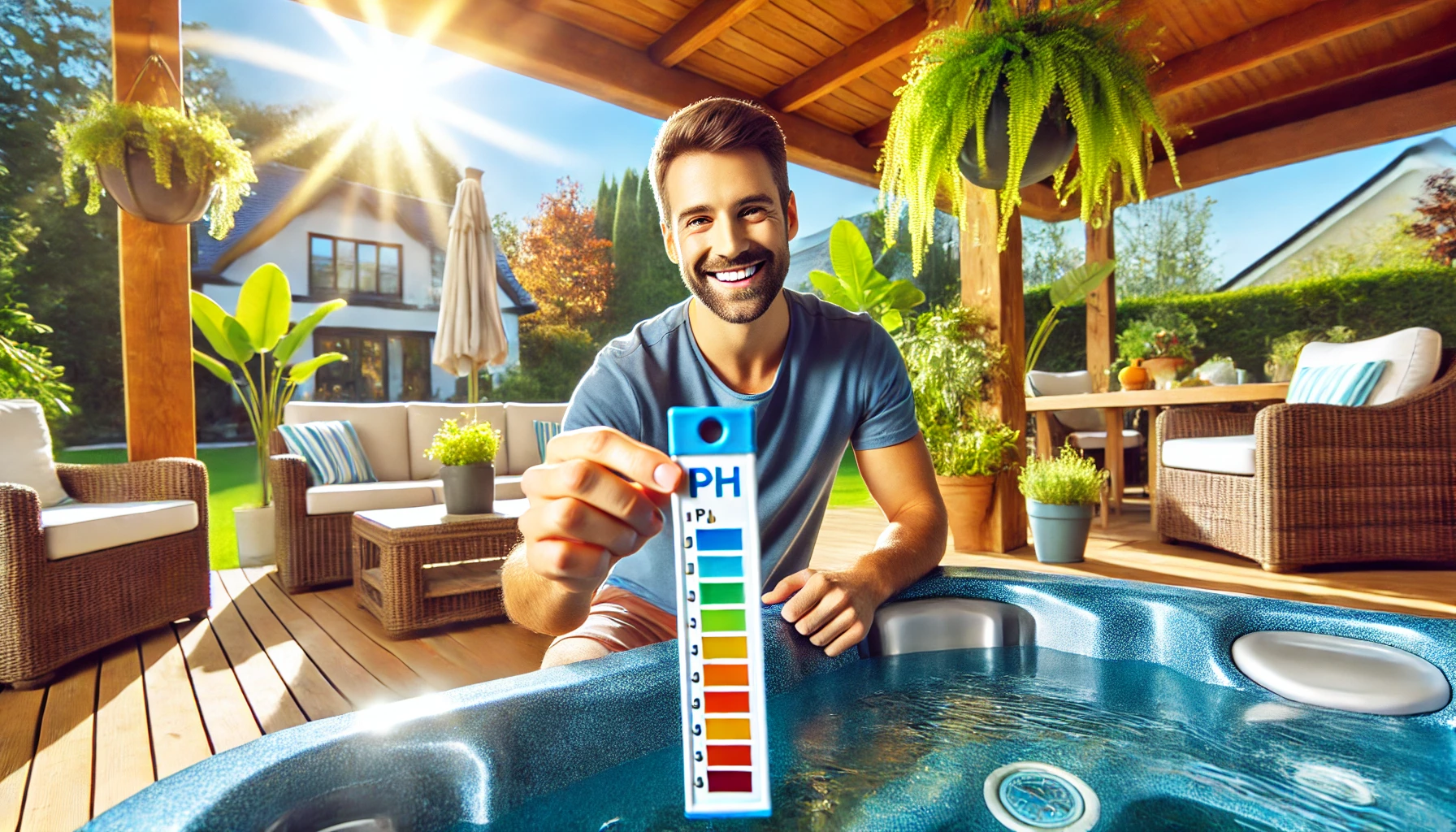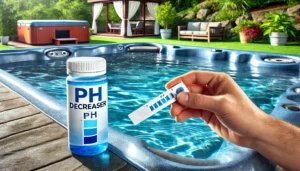Hey there, hot tub enthusiasts! Let me tell you, I’ve been in the hot tub game for years now, and if there’s one thing I’ve learned, it’s that pH is the boss when it comes to water chemistry.
Trust me, I’ve made every mistake in the book, and I’m here to save you from the same headaches I’ve had.
So, picture this: It’s a chilly Saturday evening, and you’re all set for a relaxing soak in your hot tub.
You dip your toes in, and… ouch! The water feels off, and your skin starts to itch. Yep, I’ve been there, and chances are, your hot tub’s pH is playing tricks on you.
Did you know that about 70% of hot tub issues are related to improper pH levels? Crazy, right? That’s why we’re diving deep into the world of pH today.
We’re gonna talk about why it matters, how to test it, and most importantly, how to increase it when it’s low.
By the end of this article, you’ll be a pH-raising pro, and your hot tub will thank you for it. So grab a drink (no, not the hot tub water!), and let’s get started on this bubbly adventure!
How To Increase pH In Hot Tub

To increase pH in a hot tub, add a pH increaser or alkalinity booster according to the product instructions.
Start with a small amount, wait for an hour, then retest. If needed, add more in small increments until the pH reaches the ideal range of 7.2-7.8.
Alternatively, you can use baking soda, aerate the water, or shock the tub. Remember, gradual adjustments are key to avoiding overshooting the target pH.
In the following sections, we’ll explore these methods in more detail and provide tips for maintaining optimal pH levels in your hot tub.
Understanding pH Levels in Your Hot Tub
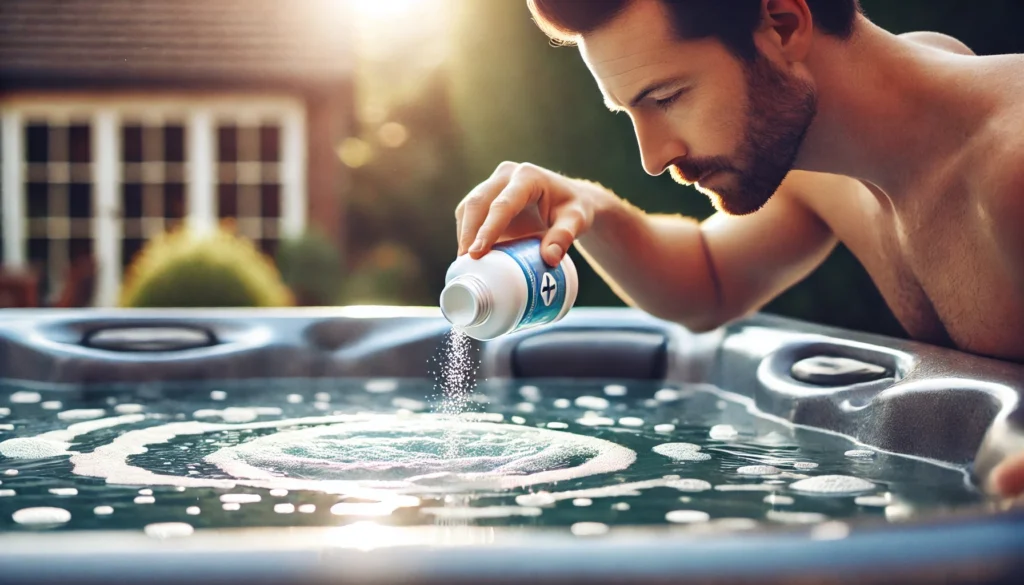
Alright, folks, let’s get down to the nitty-gritty of pH. Now, I know what you’re thinking – “Ugh, chemistry? I thought I left that behind in high school!”
But bear with me, ’cause this stuff is actually pretty cool once you get the hang of it. So, what the heck is pH anyway?
Well, it’s basically a measure of how acidic or alkaline your water is. It runs on a scale from 0 to 14, with 7 being neutral.
Anything below 7 is acidic (think lemon juice), and anything above is alkaline (like baking soda). Your hot tub? It’s got a sweet spot right in the middle.
Here’s the deal: you want your hot tub’s pH to be juuuust right – between 7.2 and 7.8. Why? Well, let me tell you about the time I ignored my pH levels.
Big mistake. HUGE. My hot tub turned into a science experiment gone wrong.
The water was cloudy, it smelled funky, and worst of all, it turned my favorite swimsuit into a faded mess. Not cool, pH. Not cool at all.
But it’s not just about keeping your swimwear in tip-top shape. When your pH is too low (meaning it’s too acidic), it can wreak havoc on your hot tub and your body.
I’m talking itchy skin, red eyes, and even damage to your hot tub’s components. Yikes!
So, how do you know if your pH is low? Well, there are a few telltale signs:
- Your skin feels itchy or dry after a soak
- Your eyes are red and irritated (and not from staying up late binge-watching your favorite show)
- The water looks cloudy or has a greenish tint
- You notice scaling or stains on your hot tub’s surfaces
- Your hot tub components seem to be wearing out faster than they should
If you’re nodding your head to any of these, don’t panic! We’ve all been there.
The good news is, it’s totally fixable. And that’s exactly what we’re gonna learn how to do.
But here’s the thing – and I learned this the hard way – you can’t just guess at your pH levels. You gotta test that water regularly.
It’s like being a scientist, but way more fun and with the added bonus of a relaxing soak afterward!
Testing Your Hot Tub’s pH Levels
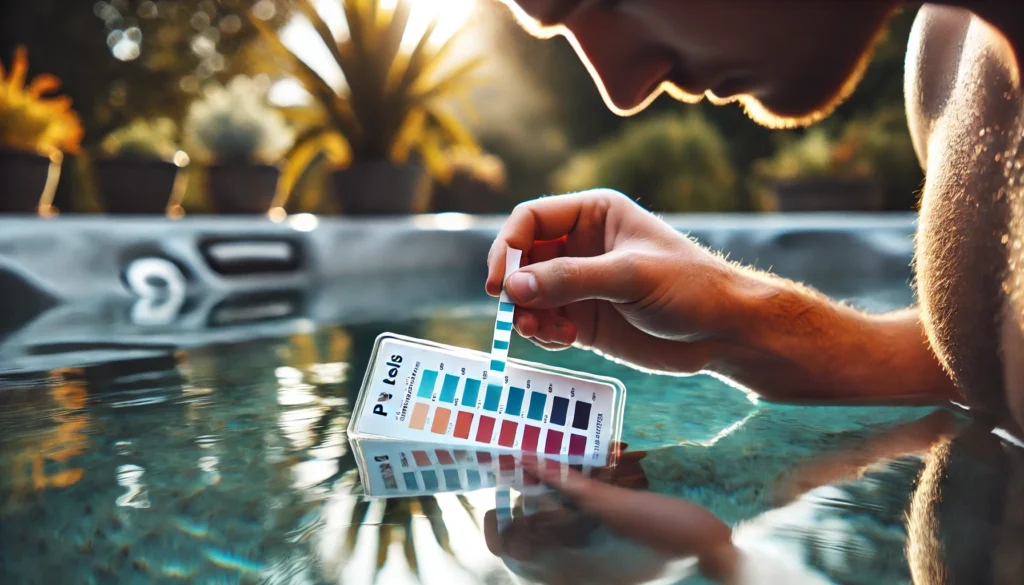
Alright, my hot tub buddies, it’s time to channel your inner mad scientist! We’re about to dive into the wild world of pH testing.
Don’t worry, no lab coat required (although, hey, if that’s your thing, who am I to judge?). First things first, you’re gonna need some tools.
Now, I remember when I first started out, I was totally overwhelmed by all the fancy gadgets out there. But trust me, you don’t need to break the bank.
Here’s what you really need:
- pH test strips or a liquid test kit
- A clean, dry container for water samples
- Your trusty eyeballs (or glasses, if you’re like me and can’t see a thing up close anymore)
That’s it! See? Not so scary after all.
Now, let me walk you through how to perform a pH test. It’s easier than making a sandwich, I promise.
Here’s what you do:
- Grab your clean container and dip it about elbow-deep into your hot tub. You want a good sample, not just surface water.
- If you’re using test strips, dip one in for a few seconds. If you’re using a liquid kit, add a few drops of the testing solution to your water sample.
- Wait for the color to develop. This is where patience comes in handy. I know, I know, waiting isn’t fun. But trust me, it’s worth it.
- Compare the color to the chart that came with your test kit.
Boom! You’ve just tested your hot tub’s pH.
Give yourself a pat on the back! Now comes the fun part – interpreting those results.
Remember that sweet spot we talked about earlier? You’re aiming for 7.2 to 7.8. If your test shows a number lower than 7.2, congratulations!
You’re in the right place, because we’re about to learn how to raise that pH. But here’s a little secret I’ve learned over the years: pH and alkalinity are like two peas in a pod.
They work together, and sometimes, if your alkalinity is off, it can mess with your pH. So if you’re constantly battling low pH, it might be worth checking your alkalinity too.
Just a little pro tip for ya! Oh, and one more thing – don’t get discouraged if your pH isn’t perfect right away.
It took me months to get the hang of balancing my hot tub chemistry. There were times when I felt like throwing in the towel (literally – I may have tossed a few test strips in frustration).
But stick with it, and soon you’ll be reading those test strips like a pro.
7 Effective Methods to Raise pH in Your Hot Tub
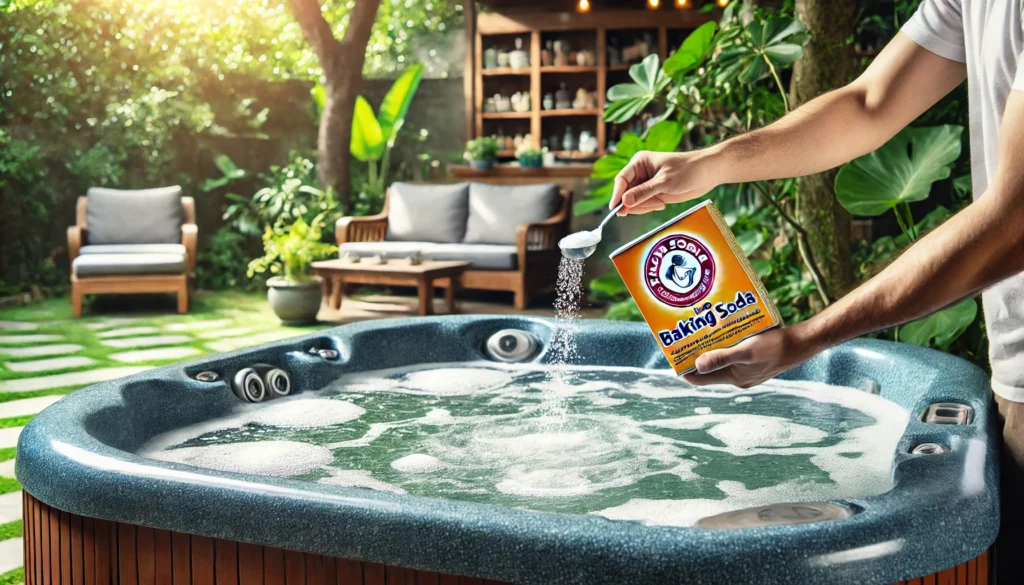
Alright, hot tub heroes, it’s time to roll up our sleeves and get down to business. We’re about to explore 7 tried-and-true methods to boost that pH level.
I’ve personally used all of these at some point, so I’ll share the good, the bad, and the bubbly of each one.
1. Using pH Increasers or Alkalinity Boosters
This is your go-to method, folks. pH increasers (also called pH Up) are specifically designed for this job.
They’re usually made of sodium carbonate or sodium bicarbonate. Just follow the instructions on the package, and you’re golden.
But here’s a pro tip: start with less than you think you need. You can always add more, but taking it out? That’s a whole other headache.
2. Adding Baking Soda
Ah, good old baking soda. It’s not just for making cookies rise or deodorizing your fridge.
This kitchen staple can also raise your hot tub’s pH. About 1 tablespoon per 100 gallons of water should do the trick.
But be careful! I once got a little overzealous with the baking soda and turned my hot tub into a giant bubble bath.
Funny? Yes. Practical? Not so much.
3. Shocking your hot tub
Sometimes, your hot tub just needs a good shock. Not the electrical kind, mind you!
I’m talking about a chemical shock treatment. This can help raise pH levels while also killing bacteria and breaking down organic compounds.
It’s like a reset button for your hot tub. Just be sure to choose a non-chlorine shock if you’re using bromine as your sanitizer.
4. Draining and Refilling
When all else fails, sometimes you gotta start fresh. If your pH is stubbornly low and nothing seems to be working, it might be time to drain that tub and refill it.
I know, I know, it’s a pain. But think of it as a spa day for your hot tub.
Plus, it gives you a chance to give everything a good scrub while you’re at it.
5. Adjusting Total Alkalinity
Remember how I mentioned pH and alkalinity are besties? Well, sometimes fixing your alkalinity can help stabilize your pH.
Aim for a total alkalinity between 80-120 ppm. If it’s low, you can use an alkalinity increaser.
Just be patient – it can take a day or two for things to balance out.
6. Using a calcium hardness increaser
This one’s a bit tricky, but hear me out. If your water is too soft, it can make it harder to maintain proper pH levels.
Adding a calcium hardness increaser can help stabilize your water chemistry. Aim for a calcium hardness level between 150-250 ppm.
7. Natural Methods (e.g., aeration)
For my eco-conscious friends out there, here’s a natural method: aeration. Simply running your jets can help raise pH levels over time.
It’s not the quickest method, but it’s gentle on your water and your wallet. Plus, who doesn’t love the sound of bubbling water?
Now, I’ve gotta be honest with you. There was a time when I tried all of these methods in one week because I was so frustrated with my low pH.
Let’s just say it didn’t end well. My hot tub looked like a mad scientist’s lab, and the water was so alkaline it could’ve cleaned my oven!
The key is patience and consistency. Pick a method, give it time to work, and test, test, test.
Rome wasn’t built in a day, and perfect hot tub chemistry isn’t achieved overnight.
Step-by-Step Guide to Raising pH Safely
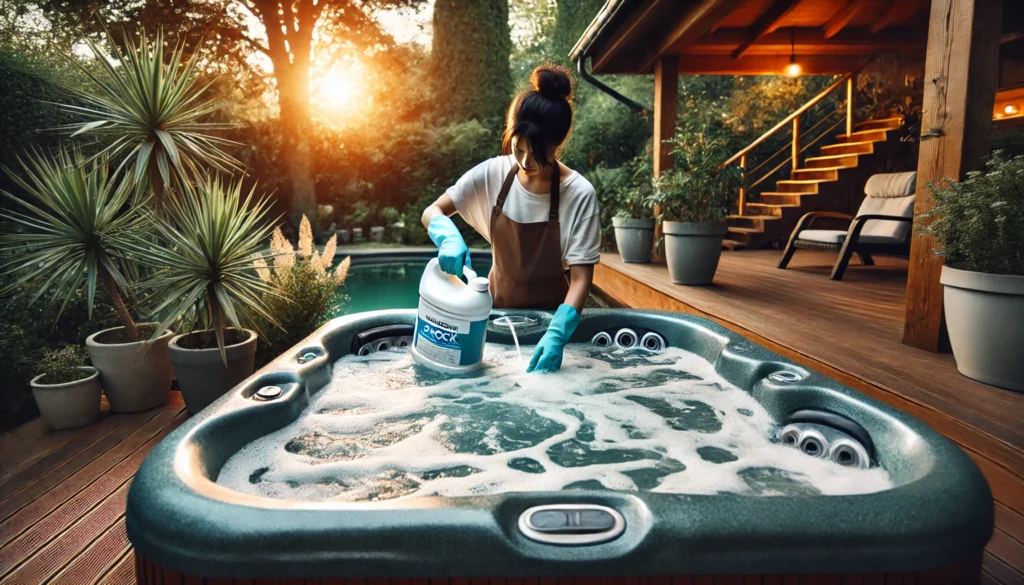
Alright, hot tub enthusiasts, it’s time to put on our safety goggles (metaphorically speaking, of course) and dive into the nitty-gritty of raising pH safely. I’ve learned these steps the hard way, so you don’t have to.
Trust me, your hot tub (and your skin) will thank you for taking it slow and steady.
Step 1: Calculate the amount of pH increaser needed
First things first, we need to figure out how much pH increaser to add. Now, I’m not gonna lie, math isn’t my strong suit.
There was this one time I added way too much pH increaser and turned my hot tub into a bubble monster. It was like a scene from a B-movie horror flick, but with more bubbles and less screaming.
To avoid my bubbly blunder, here’s what you do:
- Check your current pH level (remember our testing lesson?)
- Determine how much you need to raise it
- Check the instructions on your pH increaser product
- Calculate based on your hot tub’s volume
Most products will tell you how much to add per 100 gallons to raise the pH by a certain amount. For example, if you need to raise the pH by 0.2 in a 400-gallon hot tub, and the product says to use 1 oz per 100 gallons to raise it by 0.2, you’d need 4 oz total.
Step 2: Add chemicals gradually
Here’s where patience comes in handy. I know you’re excited to get that pH up, but trust me, slow and steady wins the race.
Add about half of the calculated amount to start. Sprinkle it slowly over the surface of the water with the jets running.
It’s like seasoning a soup – you can always add more, but it’s hard to take it out once it’s in there.
Step 3: Wait and retest
This is the hardest part for us impatient types. But you’ve gotta give those chemicals time to work their magic.
Wait at least an hour, preferably longer if you can stand it. I usually use this time to catch up on my favorite TV show or do some light cleaning (who am I kidding, I usually just scroll through my phone).
After waiting, test the pH again. Has it gone up? Great!
Not quite there yet? No worries, that’s why we started with half the amount.
Step 4: Adjust as needed
If your pH still isn’t in that sweet spot (7.2-7.8, remember?), add a little more of the pH increaser. And when I say a little, I mean a little.
It’s better to add small amounts multiple times than to overshoot and have to start all over again.
Step 5: Final test
Once you think you’ve got it right, test one more time to be sure. If it’s in range, congratulations!
You’ve just successfully raised your hot tub’s pH. Time for a celebratory soak!
Now, here’s a pro tip I wish someone had told me when I started: keep a log of what you add and when. It might seem like overkill, but trust me, it’ll save you a lot of headaches down the line.
Plus, it makes you feel like a real scientist, which is always fun!
Step 6: Run the jets
After you’ve added the chemicals and confirmed the pH is in the right range, run your hot tub jets for at least 15-30 minutes. This helps circulate the water and distribute the chemicals evenly.
Plus, it’s a great excuse to enjoy the bubbles! I remember one time I skipped this step because I was in a hurry.
Let’s just say that the next time I got in, one side of the tub felt like a bubble bath and the other like a salt lake. Not exactly the relaxing experience I was going for!
Step 7: Retest after 24 hours
Here’s something I learned the hard way: pH can be a bit sneaky. Sometimes it’ll look perfect right after you adjust it, but then it’ll drift back down overnight.
That’s why it’s super important to test again after about 24 hours. Think of it like baking a cake – you wouldn’t just check it once and assume it’s done, right?
Same goes for your hot tub chemistry. A quick test the next day can save you from a world of trouble.
Now, I know what you’re thinking – “Geez, this seems like a lot of work!” And yeah, it can be at first. But trust me, once you get the hang of it, it’ll become second nature.
And the payoff? Crystal clear water that feels amazing on your skin.
Totally worth it, if you ask me!
Preventing Future pH Drops in Your Hot Tub
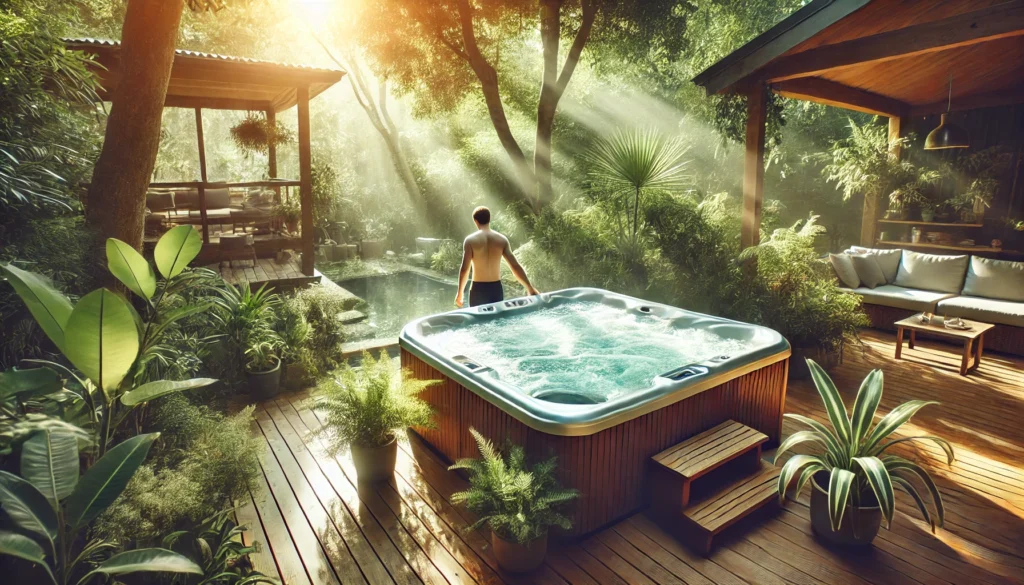
Alright, hot tub heroes, we’ve conquered the pH battle, but now it’s time to win the war. Let’s talk about how to keep that pH level steady so you’re not constantly playing chemist with your hot tub.
Regular Maintenance Tips:
- Test, test, and test again: I can’t stress this enough. Test your water at least once a week, more if you’re using it a lot.
I’ve got a little reminder set on my phone – “Test the tub, dude!” It’s cheesy, but it works!
- Keep it clean: A dirty hot tub is a pH nightmare waiting to happen. Skim out any debris regularly, and give your filters a good clean every month.
Trust me, your pH will thank you.
- Shower before soaking: I know, I know, it sounds like a buzzkill. But all those oils, lotions, and whatnot on your body can mess with your water chemistry.
A quick rinse before you hop in can make a big difference.
- Cover up: Use your hot tub cover when you’re not using it. It’ll keep out leaves, bugs, and other pH-disrupting nastiness.
Plus, it’ll save you on heating costs. Win-win!
Balancing Other Water Chemistry Factors:
Remember how I said pH doesn’t work alone? Well, here’s where we talk about its partner in crime – alkalinity.
Keep your total alkalinity between 80-120 ppm, and your pH will be much more stable. Also, keep an eye on your calcium hardness.
If it’s too low, your pH can bounce around like a ping pong ball. Aim for 150-250 ppm.
And don’t forget about your sanitizer levels! Whether you’re team chlorine or team bromine, keeping those levels steady can help prevent pH fluctuations.
Common Mistakes to Avoid:
Oh boy, have I made some doozies over the years. Learn from my mistakes, folks!
- Overreacting to small changes: A slight dip in pH doesn’t always need immediate correction. Sometimes it’ll balance itself out.
- Using too many chemicals: More is not always better. Stick to the recommended dosages.
- Ignoring other factors: Remember, pH is just one piece of the puzzle. Don’t get so focused on it that you neglect other aspects of water chemistry.
- Not accounting for environmental factors: Rain, high bather load, and even nearby trees can affect your pH. Be aware of what’s going on around your tub.
- Forgetting to balance after adding fresh water: Every time you top off your tub, you’re changing the chemistry a bit. Always test and adjust after adding water.
You know, I used to think maintaining a hot tub was a real pain in the butt. But now? It’s almost like a zen practice for me.
There’s something satisfying about getting that perfect balance, you know? And hey, even if you mess up (and trust me, you will at some point), it’s not the end of the world.
Your hot tub is pretty forgiving. Just keep at it, and before you know it, you’ll be the go-to hot tub guru in your neighborhood.
So there you have it, folks! You’re now armed with all the knowledge you need to keep your hot tub’s pH in check.
Remember, it’s all about consistency, patience, and a little bit of chemistry know-how. Now, if you’ll excuse me, all this talk about hot tubs has me itching for a nice, relaxing soak.
Here’s to crystal clear water and perfectly balanced pH! Cheers!
Conclusion
Whew! What a journey we’ve been on, huh? From understanding the basics of pH to becoming hot tub chemistry wizards, we’ve covered a lot of ground.
But hey, that’s what it takes to keep your hot tub in tip-top shape!
Let’s recap the importance of pH one more time: it’s the key to comfortable, safe, and clean hot tub water. Too low, and you’re looking at itchy skin, corroded equipment, and a generally unpleasant soaking experience.
But now you’ve got the tools and knowledge to tackle low pH like a pro!
Remember, though, every hot tub is unique. What works for my tub might need a little tweaking for yours.
Don’t be afraid to experiment (safely, of course) and find what works best for your specific situation. It’s all part of the hot tub owner journey!
And hey, let’s talk safety for a sec. Always read the labels on your chemicals, wear gloves when handling them, and keep them stored safely away from kids and pets.
Hot tub maintenance should be fun, not dangerous!
Now, I’d love to hear from you! Have you tried any of these methods? Do you have any pH-raising tricks up your sleeve that I didn’t mention?
Drop a comment below and share your experiences. We’re all in this hot tub community together, after all!
And if you’re still feeling a bit overwhelmed, don’t sweat it. Rome wasn’t built in a day, and perfect hot tub chemistry isn’t achieved overnight.
Stick with it, and before you know it, you’ll be soaking in perfectly balanced bliss.
So, what are you waiting for? Go forth and conquer that pH!
Your hot tub (and your skin) will thank you. And remember, when in doubt, test, adjust, and enjoy.
Happy soaking, everyone!
